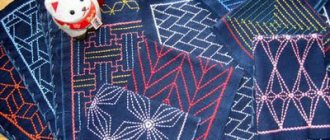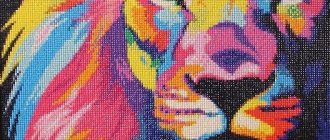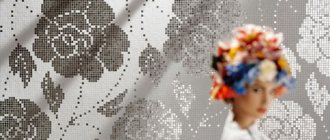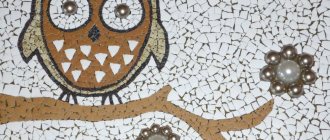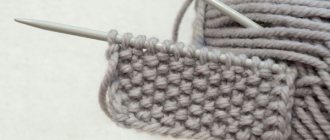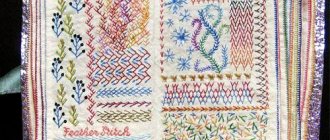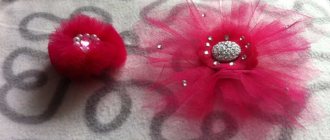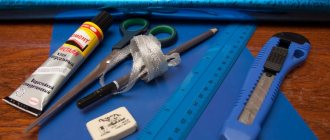From time immemorial
The desire to decorate one’s home is typical for humans. Among the many methods, such as painting or sculpture, which require the professional abilities of an artist, there are options that are quite accessible to the amateur. One of them is mosaic.
Mosaics made from broken tiles can be used to decorate not only walls, but also various design objects.
The art of mosaic has been known as a method of decoration since ancient times. The first known examples of the use of small pieces of tiles, glass smalt or stones fixed to a base with glue to create images or ornaments are dated by archaeologists to the second half of the 4th millennium BC. The mosaic technique became most widespread in Greece and Rome, as well as in the East.
The second wave of interest in mosaics as a way of decorating objects and interiors was Art Nouveau. Mosaic, with its picturesqueness and colorfulness, fits perfectly into the decorative concept of the style.
Children's fun in an adult way: do-it-yourself glass mosaic
The mosaic patterns are mesmerizing - it’s hard to take your eyes off them. Do you want to learn how to create such masterpieces? It's easier than it seems!
Among the various women's hobbies, there are those that can bring not only pleasure, but also benefit. Mosaic can be placed on a par with knitting, sewing, floriculture and cooking. The association that first comes to mind when hearing the word “mosaic” is multi-colored small figures from sets for children's creativity. Plastic circles and squares that give a unique sensation if you step on them with bare feet. Glass mosaic, made with your own hands from multi-colored pieces of glass, is completely different.
- From time immemorial: the history of fashion creativity
- What is needed for practical classes
- From preparation to action: techniques for laying mosaic modules
- Glass mosaic technique
From time immemorial: the history of fashion creativity
It turns out that the current hobby is already about six thousand. Examples of the first mosaic designs were found in excavations of Sumerian temples, which the Sumerians built sometime in the middle of the fourth millennium BC. The ancient Greeks lined the floors of their houses with designs made from river pebbles. The color scheme left much to be desired, but Greek craftsmen had enough shades of gray to create complex ornaments and designs.
Mosaics were most loved and revered in Ancient Rome. Ancient Roman generals even carried mosaic floors for their field tents during campaigns. And this was very difficult, in the most literal sense: the mosaic tiles for the floor weighed hundreds of kilograms. The first examples of glass mosaics, made of special glass, opaque, multi-colored and durable, appeared in Ancient Rome. This glass, called smalt, is still used today for their work by craftsmen in modern studios and by those who like to make mosaics with their own hands.
What is needed for practical classes
Almost any material is suitable for mosaics. It can be laid out from stones, fragments of porcelain, old ceramic tiles and even eggshells. But still, the brightest, most durable and colorful mosaic is made from glass. Colored glass for mosaics (not to be confused with stained glass, this is a completely different type of glass!) can be found in two types:
- Smalt. It is produced in the same form as two thousand years ago - in the form of a large glass pancake, which must be chopped into pieces before use. It is used in workshops by professional mosaic makers to create highly artistic works.
- Glass modules. These are glass squares of different sizes, either packaged in plastic containers or glued to paper or mesh. These are well suited for home crafts.
Smalt
Mosaic on the grid
This type of mosaic glued onto a mesh is used by master finishers in their work. It turns out nice, but a simple alternation of multi-colored glass squares on the walls is so boring! And if you are planning to renovate a bathroom or kitchen, then it’s time to try yourself in the role of an antique craftsman and an interior designer rolled into one. You can involve all household members as helpers. And even four-year-old children will be happy to assemble a drawing from multi-colored glass squares together with their mother.
From preparation to action: techniques for laying mosaic modules
To lay out the mosaic you will need:
- mosaic glass modules;
- glass cutters;
- special white glue for mosaic;
- grout for ceramic tiles;
- pencil or marker.
All these accessories are sold in finishing materials stores. First you need to come up with and draw a sketch directly on the wall, according to which the mosaic will be laid out. Separate the mosaic modules from the base on which they are glued.
Using glue, glue the modules directly to the wall, according to the sketch, face up. If necessary, the modules can be split with pliers. When the drawing is ready, you need to wait about a day for the glue to dry, and carefully rub the seams with grout. The mosaic picture is ready! Now your home has acquired a unique flair that will attract the attention of guests. All that remains is to accept compliments and answer endless questions about how to make a glass mosaic yourself.
Table top decor
There is another technique for setting mosaics. It's called "reverse dialing". Glass modules are not glued directly to the wall, but are first glued onto sheets of paper, face down. Lay out the modules on paper in accordance with a special diagram, which indicates how to arrange the modules. One fragment of the drawing is placed on one sheet. The sheets are numbered, top and bottom are indicated, and sent for installation. Fragments of the design on paper sheets are glued to the wall, wait until the glue dries, then soak and remove the paper, rubbing the seams.
It turns out to be one big picture, and if it is mounted correctly, no one will guess that it was made up of small fragments. This method of mosaic typing is used when a design is typed in one place and is intended to be mounted in another. Many mosaic studios work using this technique, sending their work to customers even in other cities. If you master the reverse typing technique well, you can find a mosaic studio and offer your services for typing mosaic fragments at home. This work is not difficult and brings in very real money.
Glass mosaic technique
In addition to decorating walls, mosaics can be used to decorate any interior item: flower pots, lamps, mirrors and even garden tables. It makes original gift paintings and souvenirs. And even if you don’t set a goal to make money from this hobby, the ability to give your home comfort and uniqueness is worth a lot. For decorations, you can use not only ready-made modules, but also pieces of glass.
Before making a glass mosaic, you need to prepare materials and tools:
- colored glass;
- transparent silicone;
- glass base;
- tile grout;
- medical alcohol;
- glass cutter;
- wire cutters;
- sketch.
- First, the design is transferred onto colored glass for mosaics. To do this, just place the sketch under the glass and circle it with a marker.
- All elements are cut out with a glass cutter, assisting the process with other devices.
- The same pattern is duplicated on a glass base.
- The colored parts are carefully laid out on the base, creating the desired pattern.
- When you get the desired pattern, the parts can be glued with silicone. It is convenient to use a syringe for this.
- The space around the picture is covered with frosted milk glass or other shades suitable for the background.
- The dried work is treated with grout.
- Clean the surface of excess grout and admire the beauty.
Flower pot decor
The surface is covered with grout
Remove excess with a cloth
As you can see, there is nothing complicated about this hobby. You can create mosaics with your children, creating original home decor and useful gifts for friends and relatives for any holiday. And if you do crafts in advance, you will always have gifts in stock.
Be sure to read about how to find time for hobbies and see what other women's hobbies there are in the world!
Mosaic materials
Mosaic panels can be made from almost any material. To make mosaics, natural stone is most often used - cut into tiles or pebbles, ceramic tiles or porcelain stoneware elements, glass smalt, beads and seed beads.
Broken tiles for creating mosaics
The choice of elements depends on your creative idea and the purpose and operating conditions of an object or room decorated with a pattern of small parts. For example, to create a decorative panel in the kitchen, you can use cereals, pasta, coffee beans or spices as materials. Of course, if the surface decorated with mosaics is exposed to moisture, then pasta will not be suitable as a material.
Beautiful drawings for mosaics (video)
Laying out mosaic drawings is a very complex and lengthy process, especially for those who are faced with this type of work for the first time. But if you consider that this is a fascinating process, as a result of which you can get a unique and inimitable process, then it’s worth working on the creation. If you are a fan of creative renovations, then we recommend that you try yourself as a creator and create a mosaic masterpiece.
Roman, Florentine, Byzantine
In addition to the variety of materials, there are various techniques for laying mosaics. Experts distinguish the following main types:
- Roman mosaic;
- Florentine mosaic;
- Byzantine mosaic technique.
When making mosaics using the Roman technique, elements of various sizes are used. Most often, these are square-shaped pieces of marble of various colors and formats. To create a more accurate contour, additional chopping of the square element is used, turning it into a trapezoid or triangle.
Mosaic in Roman technique
There are several types of Roman mosaic techniques:
- “Opus tessellatum” - elements larger than 4 mm are used.
- “Opus vermiculatum” - laid out from parts measuring less than 4 mm.
- “Opus regulatum” - masonry in a line of elements of the same size and shape, used to create geometric patterns.
- "Opus sectile" - or piece mosaic. To perform this, plates of different shapes and sizes are used, which are selected according to the drawing.
Florentine mosaic is the most labor-intensive and expensive. In it, elements are cut out from stone, wood, mother-of-pearl or other materials along the contour of the design. The individual parts are pressed tightly against each other so that the seam between the elements of the design is minimal. If the material has its own pattern or texture, such as veins of marble or wood fibers, then the parts are cut taking into account the pattern of the material so that the pattern of the material is included in the laid out image.
Florentine mosaic
Byzantine mosaic is similar to the Roman "Opus vermiculatum". The pattern is made up of identical small square modules made of smalt glass. High image quality was achieved through the use of very small details. In addition, the angle at which the element was glued into the base played a certain role in the decorative effect of the mosaic panel: smalt elements glued at different angles reflected light differently, creating additional decorative effects. The view of Byzantine mosaics was supposed to be from a great distance.
Byzantine mosaic
Types and characteristics of mosaics
Mosaic from Lat. “Musium” means “dedicated to the muses” - this is a drawing made up of small pieces or various materials.2. Smalt mosaic is the same glass mosaic, but with the addition of potassium salts. Smalta is one of the relatives of Murano glass: just as bright, but much stronger and completely opaque. To produce smalt mosaics, glass is ground into powder and “baked” a second time with special dyes. Each piece of smalt has its own color and tone, as well as a gloss or matte surface. An artist or designer puts these small plates into picturesque chords, which then create a pattern or ornament, a painting.
"Golden mosaic" It is manufactured using a completely handicraft method using ancient technology. Production begins with the traditional blowing of vessels from very thin transparent glass (0.2 - 1 mm thick). The large “bubble” obtained in this way is called soffione. This glass is cut into squares measuring approximately 10 x 10 cm. Such gold mosaic plates are called “cartelline”.
A metal sheet of yellow or white gold is laid on a thin plate of gold mosaic “cartellina”. A sheet is a thin foil obtained by beating metal by hand. For example, from 20 gr. gold yields 6 square meters of foil.
A hot mass of thicker glass is poured onto a thin plate with foil. In this way, both glass layers are tightly connected and form a golden “pancake”. After this, the golden “pancakes” are sent to a kiln for hardening. A thin glass can be colored, a thick plate of gold mosaic can be green and blue, or transparent (crystal base).
The surface of the gold mosaic can be smooth or corrugated. The pancake is cut with a special glass cutting tool made of very hard hardened steel. Cutting gold mosaic into tesseras, writes Infobud, is done by hand.
3 . Ceramic mosaic is externally similar to ceramic tiles, but with much smaller dimensions, while the surface can be glazed, embossed, with additional inclusions. It is stronger than glass mosaic and is suitable for covering a wide variety of surfaces.
4. Stone mosaic - in the production of such mosaics, a variety of types of stone are used, starting with cheap tuff and ending with the rarest types of marble, onyx and jasper. oh, the stone can be polished, or vice versa. The shape of the particles is to taste.
Marble mosaic. If you buy mosaics from natural or agglomerated marble, you should keep in mind that these are relatively soft materials, when caring for which you cannot use abrasives external cleaning agents and hard brushes that can leave scratches on the polished surface. It is necessary to avoid contact with acid-containing liquids on their surfaces - fruit juices, wine, vinegar, etc. Most products made from these materials are recommended after installation in places with intensive use of the floor. with special wax. The exception is quartz-based agglomerates.
5. Non-traditional materials. There are both precious materials and universally respected porcelain tiles. Porcelain stoneware is stronger than just ceramics, and much cheaper. It is important to follow the correct manufacturing technology, otherwise the porcelain stoneware begins to delaminate and lose color. Metal mosaic - stamped metal caps 4 mm high from a half-millimeter stainless steel sheet, fixed on a patented rubber backing, which Raya gives the tile the necessary degree of rigidity. The surface of the steel is made polished, matte, with notches of various types and, finally, covered with a thin layer of brass or bronze. This material is quite expensive, but it makes an excellent decor.
Of course, the most expensive materials used in mosaics are gold and platinum. There are series in which the mosaic is made by hand from start to finish, placing real 99-carat gold foil between two layers of glass. Most often, gold mosaic is used individually, making inserts. Similar products are offered for both walls and floors; the inclusions look especially beautiful at the bottom of the pool.
Broken tile mosaic
One of the varieties of modern mosaics is trencadís. A real masterpiece in this technique are the creations of Antonio Gaudi, as well as his student and associate, Josep Maria Huhoy. It is Gaudi who is credited with creating this colorful mosaic technique.
The trencadís broken mosaic technique dates back to Roman piece mosaics, but in modern versions it uses broken ceramic tiles, broken dishes, and fragments of glass bottles. It’s quite easy to create a mosaic using the trencadís technique with your own hands: remember labor lessons in elementary school.
Gaudi's lizard in Park Guell, Barcelona
The simplest ornaments can be laid out without specific patterns, focusing on your own taste and sense of harmony.
Of course, to create masterpieces in the spirit of the work of Haris Cevis, a designer and artist who also uses the trencadís technique in his works, artistic abilities will be required. But here you can “get out”: some computer programs for editing images, for example, PhotoShop, have a function that allows you to automatically split the image into local color spots. Using the program settings, you can adjust the image detail. Having processed any photo in this way, you can print the image and use it as a sketch.
A sketch for a mosaic can be created from a photograph
Where can you use broken tile decor using the trencadís technique?
To decorate with broken tiles, you can use any surface: household items - garden table, flower pots, garden paths, fences. You can finish the walls and floors of a bathroom or kitchen. For a kitchen apron, it would be especially stylish to use a mosaic made of broken tiles with the inclusion of elements of broken dishes.
Attention! The edges of tiles or broken dishes may have sharp edges. If you plan to use the mosaic on the floor or in places that can be touched, you need to additionally sand the edges.
Select an image that suits your taste, then select elements based on color, shape and size. The mosaic can be laid using regular tile adhesive.
Advice. When using tile adhesive, do not use a large volume, because laying mosaics is a painstaking task.
After the glue has dried, the seams between the mosaic elements must be grouted using regular grout. In the video you can watch in detail the process of making panels from broken tiles.
Mosaic creation process
Mosaic made from broken ceramic tiles is an original and stylish decor that will decorate any interior, making it unusual and memorable. In addition, making mosaics with your own hands is a way to realize the creative potential that any person has.
